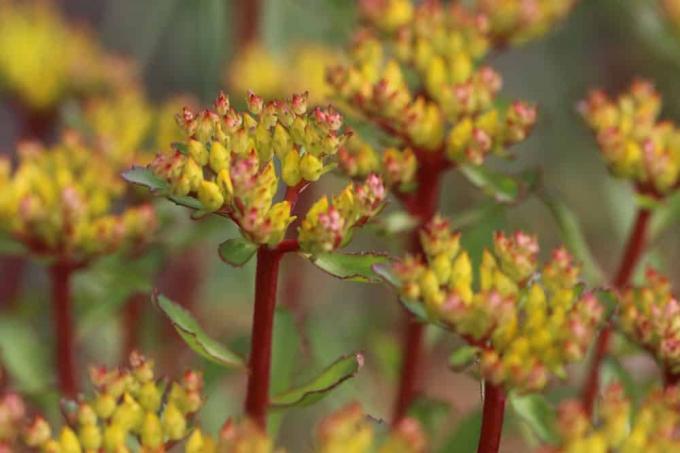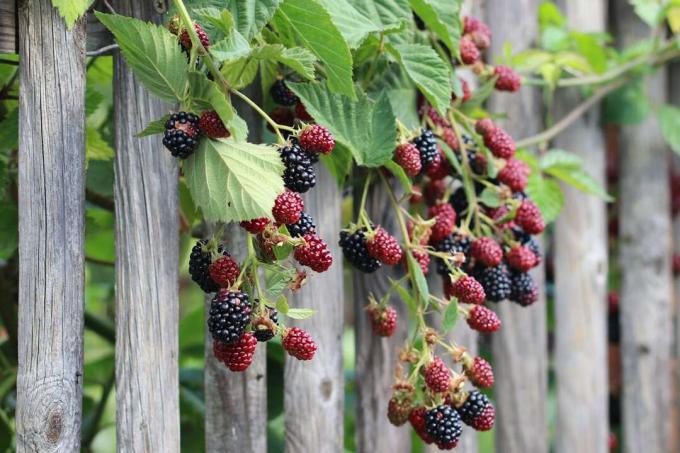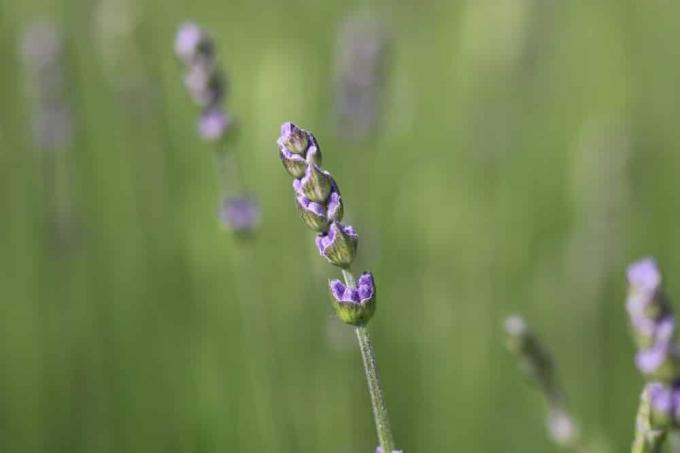

Table of contents
- Step 1: Choosing a date – when is the best time?
- Step 2: preparatory work
- Step 3: Thin out
- Step 4: Shorten shoots
- Step 5: Repotting and Root Pruning
- Special case vase cutting - How to cut flower stalks for the vase correctly
Are wilted flowers, long stunted shoots and a misshapen habit a thorn in your side? Then bring your fat hen back into shape with a skilful pruning. The bizarrely striking growth of the popular garden and house plant raises questions about timing and pruning. These instructions explain in 5 steps when and how to cut stonecrop correctly.
Step 1: Choosing a date – when is the best time?
When sedum plants bathe the garden, balcony and window sill in a sea of color in late summer, no one thinks of cutting back. In fact, the multifaceted species and varieties retain their decorative charisma well into winter. It is the shapely seed pods that set eye-catching accents indoors and outdoors during the cold season.
For the hardy survivors within the genus, withered flowers and seed heads also act as a natural protection against frost and snow. In order for a fat hen to be able to hibernate undamaged, the time window for pruning does not open until early spring. The following dates have proven themselves in practice:
- Houseplant: in March
- Bedding plant in winter quarters: before clearing in April
- Garden plant: in good time before fresh sprouting - depending on the region between the end of March and the beginning of May
Ideally, you should cut back sedum hens outdoors on a dry, frost-free and overcast day. The magnificent succulent plants have a soft spot for sunny locations. Of course, under the influence of direct sunlight, the fat hen does not want to be cut.
Tip:
Frost-sensitive sedum hens in balcony boxes or pots ideally overwinter in bright, frost-free winter quarters. From November to February, the succulents stay at 5 to 10 degrees Celsius and stop growing completely. During this time, care is limited to a small sip of water from time to time so that the substrate does not dry out completely.
Step 2: preparatory work

A fat hen should be spared fuzzy scissors and dirty blades. Frayed cuts provide ideal targets for pathogens and pests. In most cases, the pathogens are already lurking on the cutting edges if they have not been cleaned after pruning infected plants. Therefore, please pay particular attention to the following preparatory work:
- Sharpen the blades of scissors or knives
- Take a clean cloth or kitchen fleece
- Moisten with spirit or high-proof alcohol
- Thoroughly wipe the cutting tools
Have pieces of kitchen paper or Tempo tissues ready to stop the sap flow on houseplants before they soil your window sill or floor. It is also advisable to wear gloves. The sap of the plant is slightly toxic and can trigger an allergic reaction if it comes into contact with the skin.
Step 3: Thin out
Tall sedum plants, such as Sedum spectabile or Sedum telephium, can reach majestic heights of up to half a meter. Sometimes some of the numerous species and varieties tend to become woody and bare. The third step of these instructions is intended for these plants in order to free them from ballast. How to do it right:
- Cut off lignified, old shoots at the base
- Thin out bare branches from below
- Remove weak, thin shoots close to the ground
This approach is aimed at a light-flooded fat hen whose shoots are covered in foliage from root to tip.
Step 4: Shorten shoots
In 2011, the Association of German Perennial Gardeners named Fette Henne Perennial of the Year for the second time. The plant owes this title to its magnificent appearance, which hardly requires any care. Planted correctly in a sunny location, fertilizing and watering are of secondary importance. It is also up to you to decide whether you want to cut back the shoots at all or just clean out the withered flowers. Experience has shown that bushy, compact growth is promoted by targeted pruning. This incision guarantees a perfect result:
- Clean out all withered flowers or seed heads in early spring
- Optionally cut back shoots that are too long by one to two thirds
- Ideally cut a few millimeters above a leaf or bud
- Cover cuts with a strong discharge of juice with a piece of fleece

A topiary is particularly recommended when a fat hen develops long, thin shoots and falls apart. This unnatural increase in length occurs primarily during the dark season when stonecrops overwinter as houseplants on the windowsill. Under the influence of normal room temperatures and lack of light, long thin scary shoots are formed. The damage is remedied by immediately moving to a bright, slightly warm room and cutting back into the healthy area of the affected shoots. If the right winter quarters are not available, compensate for the lack of light with a daylight lamp.
Step 5: Repotting and Root Pruning
Overwintering, cutting and repotting go hand in hand when caring for sedum hens. This applies equally to indoor and balcony plants. If you leave it at a pruning, the stressed plant will lack enough energy for fresh shoots. Therefore, pot out the fat hen and remove the leached potting soil.
Examine the substrate-free root ball closely for damaged or dead roots. With sharp scissors you can cut out the strands. Finally, pot the plant in fresh succulent soil enriched with lava granules. Commercial potting soil is too nutritious for sedum hens and causes masty growth. In a lean substrate with a pH of 6.5 to 7.3, the plants will develop a compact, stable habit.
After the care measure, treat the exotic potted plant to a phase of regeneration. For this purpose, assign your stonecrop to a semi-shady, warm location. Since fresh substrate is usually pre-fertilized, do not apply fertilizer. The plant is now grateful for a sip of soft water.
Tip:
Sedums lend themselves to virtuoso creations that are unique in the plant kingdom. The succulent plants stage their striking silhouettes in worn-out shoes, old zinc tubs or antique porcelain bowls. A little soil and a drain are enough for the furious fireworks of colors and shapes to unfold.
Special case vase cutting - How to cut flower stalks for the vase correctly
The magnificent stonecrop and other tall species are suitable for cutting in a vase. Cut off the stems when the flowers have just unfurled. Placed in fresh water, the impressive bouquet spreads its exotic flair for several weeks. When cutting the vase, place the scissors one to three fingers above the ground. As long as at least one eye stays on the shoot, the fat hen will happily sprout again.
 Home editorial office
Home editorial office
Learn more about pruning

Eucalyptus dried up: cut back now?
When a eucalyptus dries up, some owners immediately think of cutting it back. Because they want to see fresh green bud quickly. The chances of that happening may be good. But one thing must not be left out: research into the causes! Otherwise a new cycle of drying up and cutting begins.

Cut blackberries: Instructions for the right cut
Bramble branches only bear fruit for one summer, after which they are used up and die off in winter. It's a good thing that new canes grow back in time for the following year. Cutting care means: What no longer supports should be removed, young rods must be optimally trained.

cutting snowball | 13 tips for pruning
When it comes to snowballs (Viburnum), the opinions of numerous hobby gardeners differ when it comes to cutting. Main reason against pruning: Destruction of the natural appearance by pruning. Find out now when it is unavoidable and which tips should be heeded.

Cutting sage: 6 tips for cutting back
Cutting measures and their ideal time depend on the species of sage plants, because they have differentiated ways of life. There are woody and herbaceous representatives that require different attention. In order to carry out the measures, a basic set of tools is helpful.

Pruning hydrangeas: when is the right time?
Hydrangeas are a real beauty because of their flowers. In the long term, however, the flowering power is only maintained if regular pruning takes place. Because cutting off withered or dried plant parts offers protection. The following guide shows when this measure should be taken.

Cutting Lavender | When is the best time?
Lavender is a popular perennial, but difficult to cut. Without regular pruning, the shrub becomes lignified and less robust. Choosing the right time is important for pruning. When to cut depends on the use of the perennials.


